Story at a glance:
- As a response to major environmental stressors, resilient building is all about solving problems for longevity, innovation, and adaptability.
- These resilient building examples from around the world are focused on using reclaimed materials and finding new ways to produce energy that’s both beautiful and resilient.
- Resiliency is not only about building in harmony with our climates but also about how community wellness is affected by a building’s exposure to light and open air.
Resiliency is simply the ability to endure. In the green building industry resilient building means designing for increased longevity with the use of sustainable materials, withstanding extreme weather brought on by climate change and having a more positive impact on the environment.
“I see resiliency as a key component in green construction and design,” says Jeff Yelle, director, OSB/EWP technology at LP Building Solutions. “When products are able to withstand greater challenges from the environment and weather events, this translates to less rebuilding and, in turn, less waste and less energy consumption,” Yelle previously told gb&d.
Here are 15 resilient building examples that highlight different facets of resiliency.
15 Resilient Building Examples to Inspire the Next Generation
1. Acton Passive House, Acton, MA
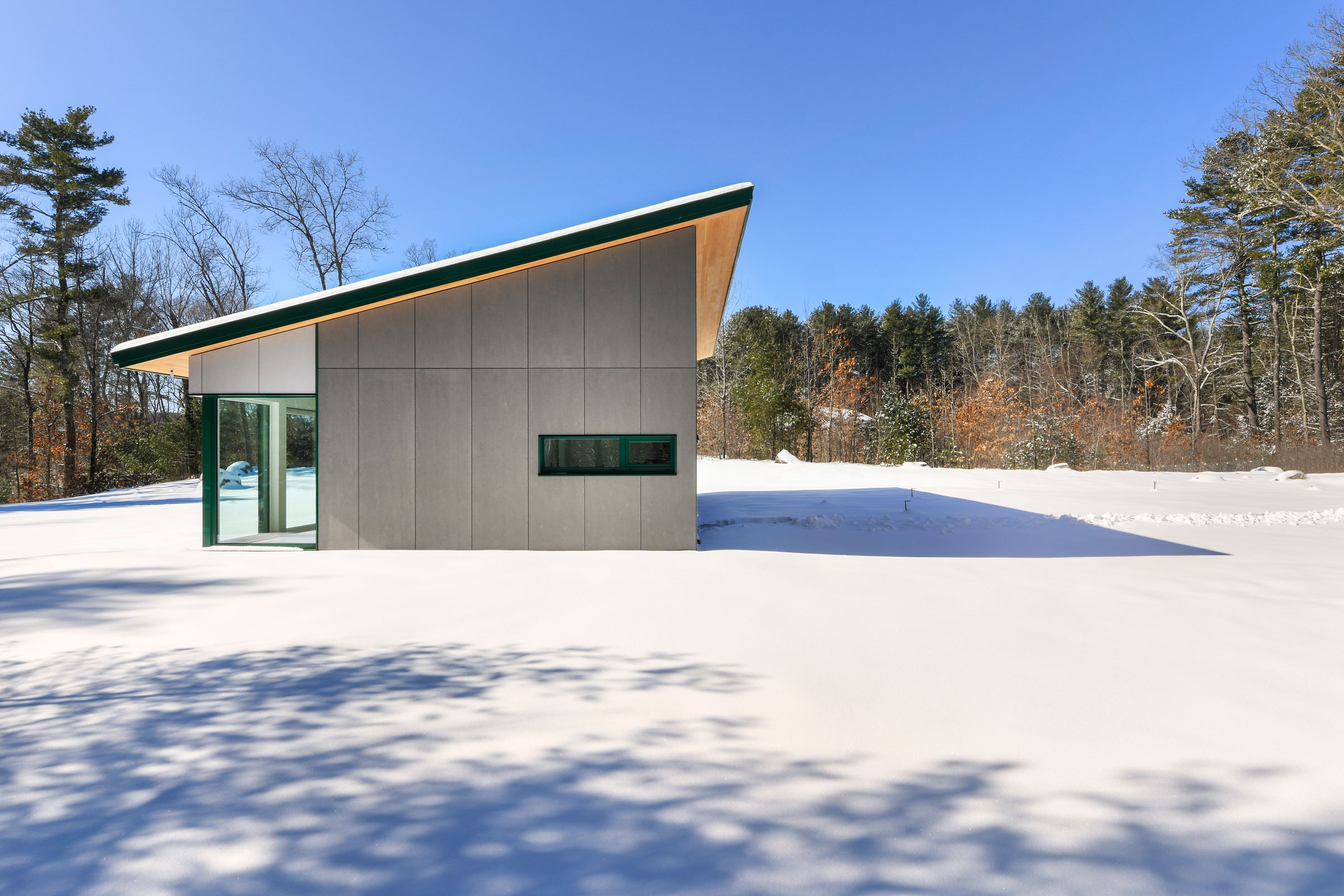
The Acton Passive House designed by ZeroEnergy Design is tucked into a clearing in the woods. Photo by Nat Rea
Nestled into a remote clearing in the woods of Massachusetts, the unassuming Acton Passive House—certified to both the PHIUS and Source-Zero standards—is a simple-yet-efficient residence that produces all of its own energy via a rooftop solar array.
Designed by Boston-based architecture firm ZeroEnergy Design (ZED), the Acton Passive House utilizes dense-packed cellulose insulation wrapped in wood fiberboard—both of which possess a very low or negative embodied carbon—to help passively retain thermal heat energy during the cold winter months. Rigorous air sealing and high-performance windows further serve to reduce the home’s energy consumption.
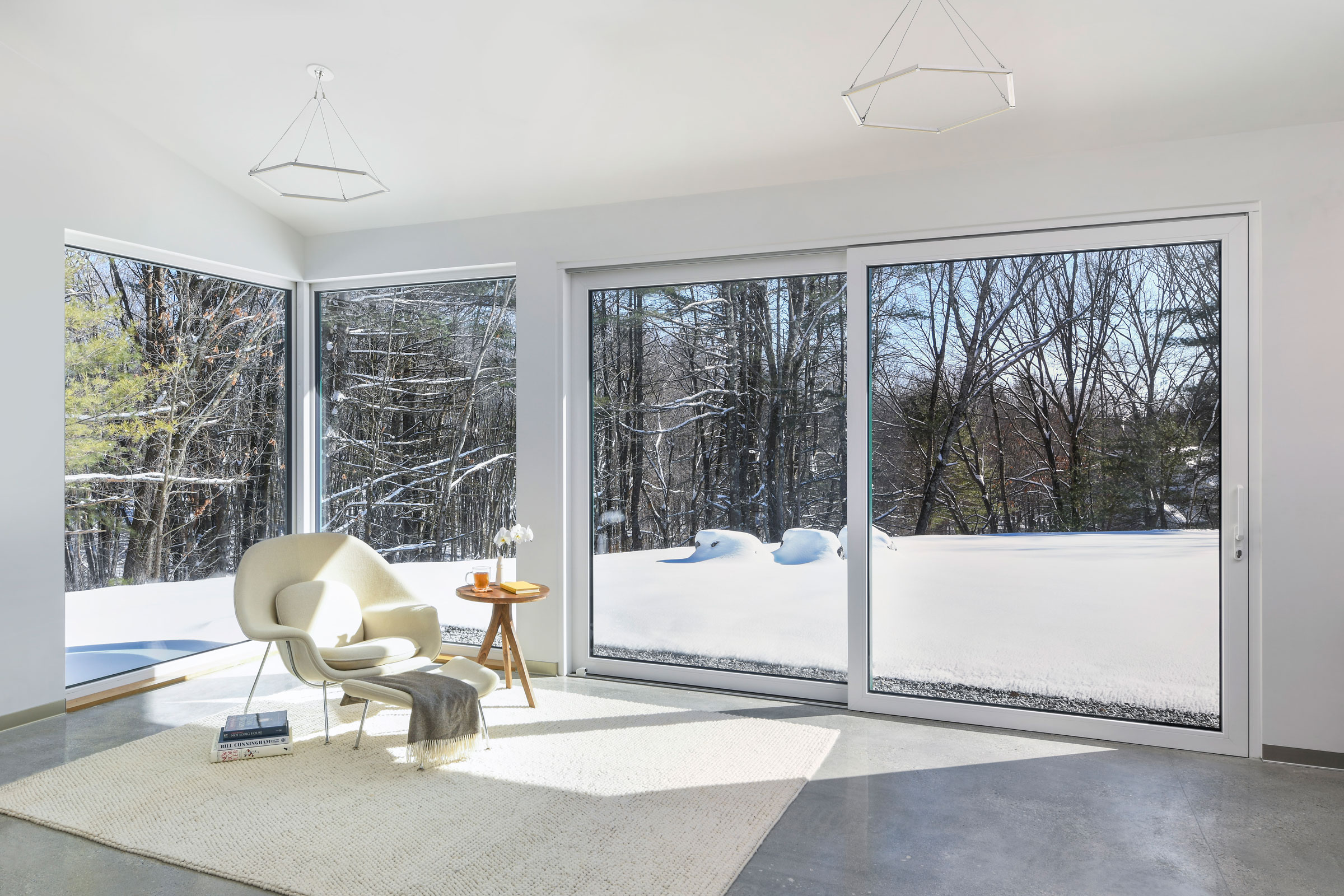
Passive systems, energy-efficient windows and doors, dense-packed cellulose insulation, and thorough air-sealing allow the Acton Passive House to greatly reduce its carbon footprint. Photo by Nat Rea
To minimize the home’s overall environmental impact ZeroEnergy Design elected to construct the Acton Passive House primarily from wood and fiber cement, reducing the amount of concrete required for the build. Both products can be composted or recycled once they reach the end of their operational lifespan, minimizing the amount of landfill waste.
“What we were able to do on this project was rely on a wood structure and minimize the concrete, which typically has the highest carbon impact. Through the process we wanted to make sure we weren’t just looking at operational carbon but also considering the embodied carbon—the carbon that goes into the construction,” Stephanie Horowitz, lead architect and managing director at ZED, previously told gb&d.
2. Casa Adelante, San Francisco
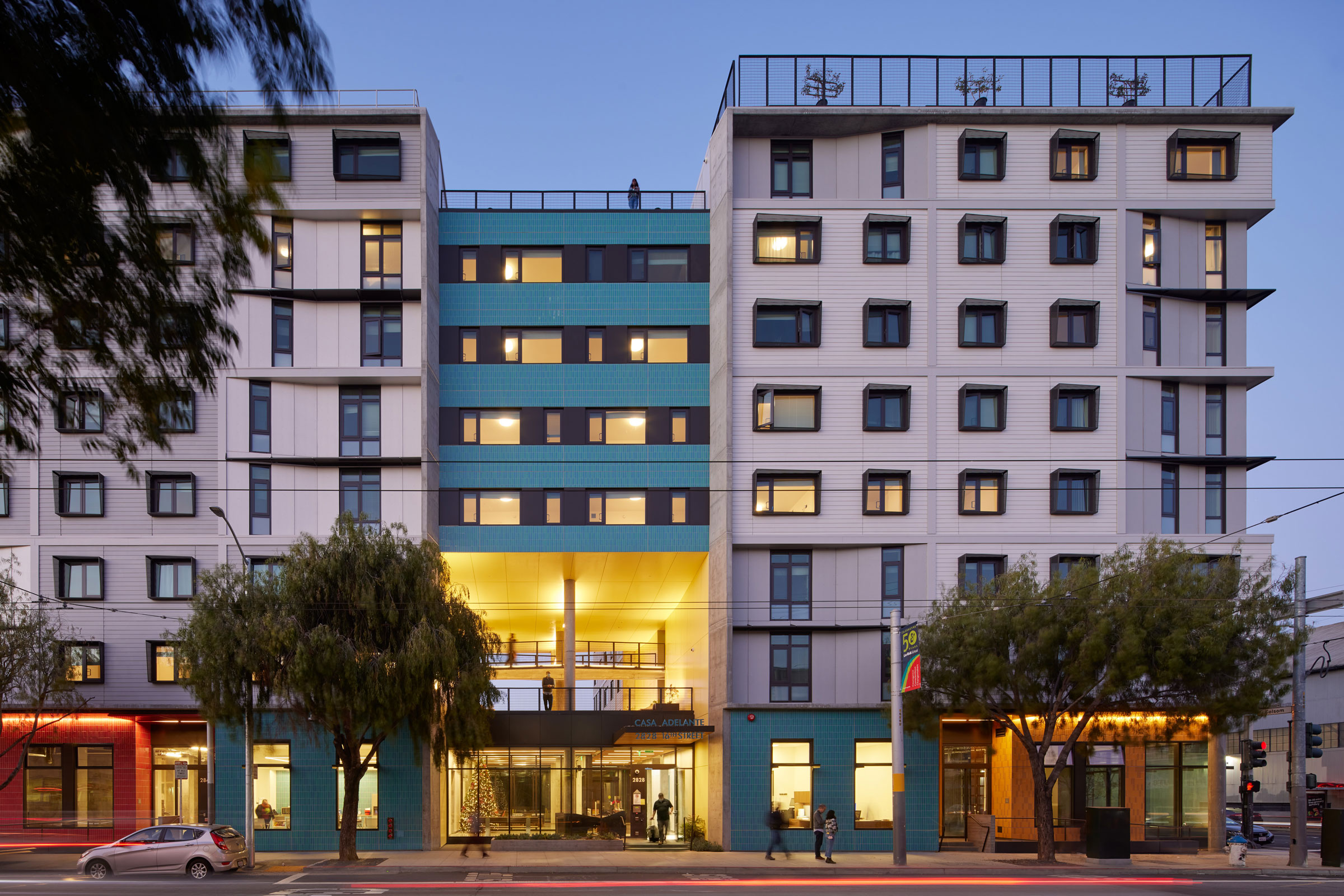
Leddy Maytum Stacy Architects worked with Mission Economic Development Agency and the Tenderloin Neighborhood Development Corporation to foster and celebrate an interconnected and vibrant community as part of the Casa Adelante 2828 16th Street project. The colorful tiles seen on the exterior are from Daltile’s Natural Hues Collection. Photo by Bruce Damonte
Designed by Leddy Maytum Stacy Architects (LMSA), the Casa Adelante housing project on 2828 16th in San Francisco’s Mission District—an area populated largely by families of Latin American descent—is an excellent example of how affordable and sustainable housing can foster cultural, social, and environmental resilience.
Casa Adelante is first and foremost an affordable public housing project, but that’s not all. In addition to its 143 apartment units, the project also boasts an art gallery, community room, child care center, and a youth empowerment organization. All of the ground floor amenities are interconnected to facilitate movement, interaction, and relationship-building, while also allowing for easy transitioning into event space when necessary.

Casa Adelante’s seventh floor and roof deck are dedicated to urban agriculture, allowing residents to grow a portion of their own food. Photo by Bruce Damonte
Residents of Casa Adelante also have the opportunity to grow their own food, as both the seventh floor and roof are dedicated to urban agriculture and food production. “Food insecurity is a very big and valid concern for the populations the building serves,” Ryan Jang, principal at LMSA, told gb&d in a previous article. “This idea of combining food and housing security together helps with these huge housing issues that are present in San Francisco and elsewhere.” A rooftop photovoltaic solar array and solar hot water ray allow the building to produce a portion of its own energy, too.
Because California is prone to natural disasters, Casa Adelante also features a range of precautionary and preparedness measures. The building’s ground floor is raised above the floodplain and any water that is not retained by the roof’s agricultural beds is routed to large stormwater planters in the building’s inner court/adjoining residential open space—both of which help reduce flood risk. A centralized ventilation and air filtration system ensures that residential units will receive clean air even when the skies are filled with smoke from wildfires.
Casa Adelante’s interior receives plentiful natural light and primarily features concrete, metal, fabric, FSC-certified wood, and other sustainable materials. “We tried to keep things as natural and durable as possible—from the concrete floors to the metal in the reception desk to the wood ceilings to the fabric wrapped acoustical panels,” says Jang. “It just seemed like a simple and healthy thing to do.”
3. Silver Rock Living Building Home, Bainbridge Island, WA
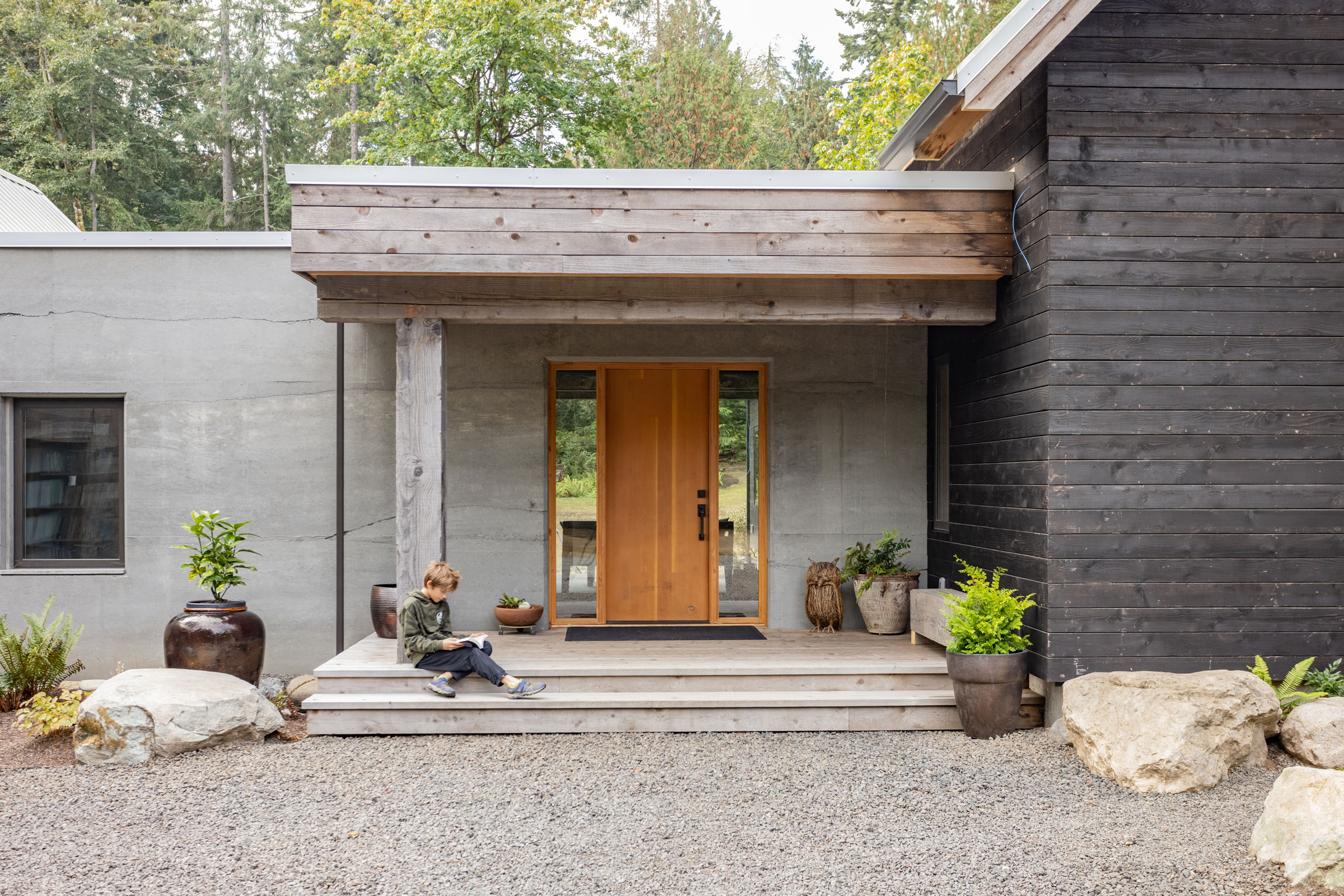
The Silver Rock residence on Bainbridge Island is a Living Building designed by McLennan Design. Photo by Emily Hagopian
On Bainbridge Island, Washington and designed by McLennan Design, the Silver Rock Living Building Home is a masterclass in resilient, sustainable building practices. Certified to Living Building Challenge standards, the home boasts a drastically reduced environmental impact and acts as an extension of—rather than an intrusion upon—the surrounding landscape.
In its construction the Silver Rock Living Building Home makes use of sustainable, locally-sourced materials, many of which came directly from the site itself. The home’s central corridor—affectionately nicknamed the “Hallway of Life”—features a reinforced and insulated rammed earth wall made from soil gathered on-site and from nearby quarries.
In addition to rammed earth the home also makes extensive use of reclaimed and FSC-certified timber. “Even trees from the site that were cut down for the project were milled and used in a variety of ways, including for all of the exterior siding (cedar) and some interior wood (Douglas fir),” Jason McLennan, principal and founder of McLennan Design, previously wrote for gb&d. “The effort created a ‘localist construction’ with considerably reduced embodied carbon and habitat impacts compared to most new homes.”
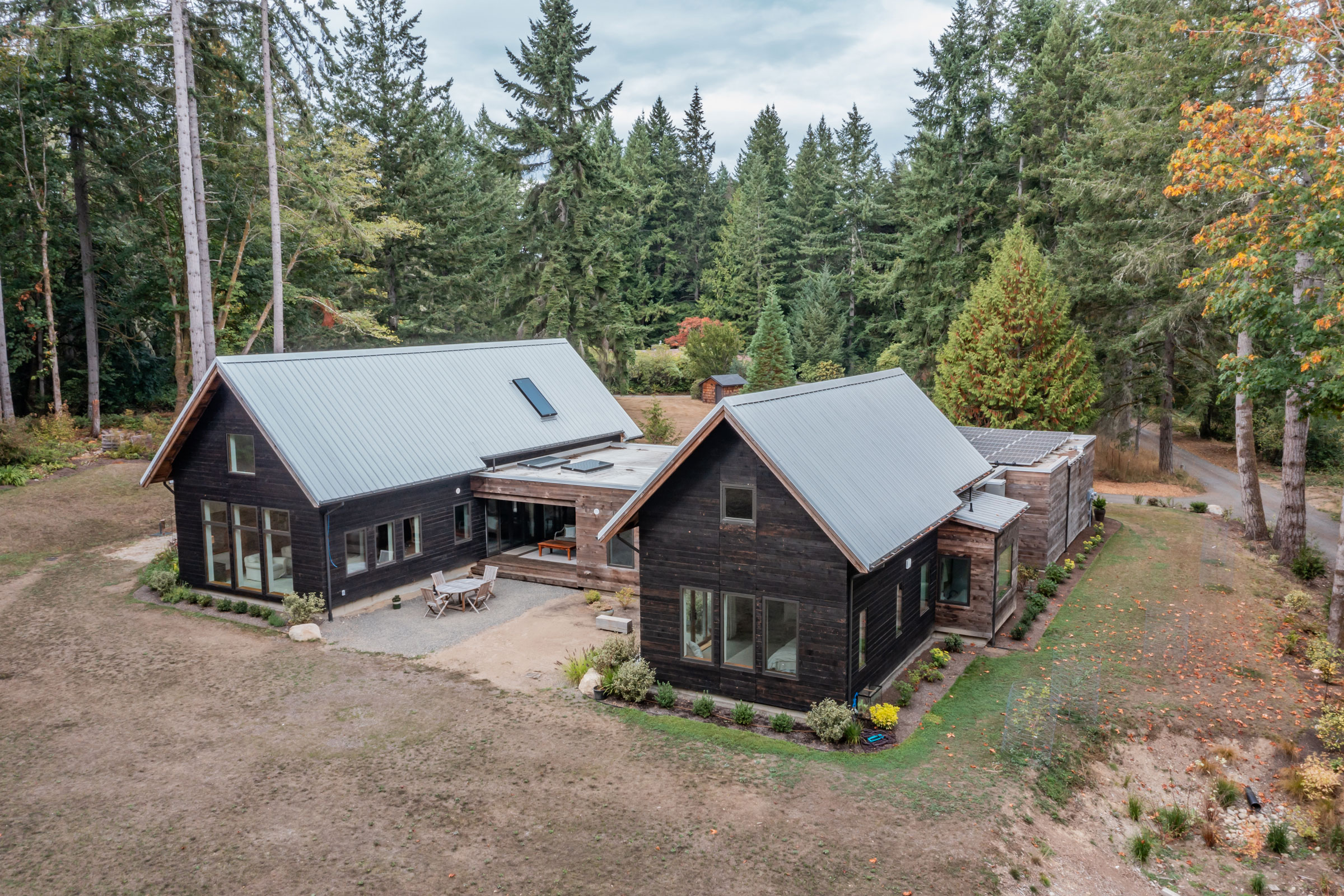
The Silver Rock Living Building Home was carefully designed so as to make the most effective use of natural processes and minimize its environmental impact as much as possible. Photo by Emily Hagopian
Through careful planning the McLennan Design team was even able to figure out how to incorporate passive solar principles and on-site solar energy production in an area dominated by tall, shade-casting trees. To achieve the former, a small clearing was created to the south of the home and all major internal spaces were oriented towards the sun. Solar panels were then installed on the most northeastern portion of the property—the garage—to take advantage of the sun it receives year round.
Aside from these passive solar design elements, Silver Rock makes use of abundant insulation, energy-efficient windows, airtight construction, underfloor radiant heating, and a heat recovery ventilation system to ensure maximum efficiency and comfort throughout the year. In order to preserve the surrounding habitat for future generations, a large portion of the property was set aside as a land trust.
4. Thaden School’s Home Building, Bentonville, AK

Thaden School sits on a 26-acre site in Arkansas. Here, the Home Building is seen in the rear of campus. Photo by Tim Hursley
Designed by EskewDumezRipple for the Walton Family Foundation, the Thaden School’s Home Building in Bentonville, Arkansas is a sustainable, resilient addition to an already impressive alternative learning campus.
Playing host to the school’s meals program, a state-of-the-art teaching kitchen, and dining hall, the Home Building acts as a hub for “learning by doing,” a principle that defines the Thaden School’s approach to education as a whole. At the building’s rear, an ever-present water-lab collects a large portion of onsite rainwater and serves as a teaching opportunity for showcasing certain biological processes.
But it’s not just what’s inside the Home Building that’s impressive; the adjacent landscape is also an expertly crafted learning opportunity. Designed for minimal maintenance while encouraging biodiverse plant life, the grounds around the Home Building are home to native ecosystems as well as orchards, planter boxes, and fruit and vegetable fields. These crops are harvested by students and then cooked and prepared in the dining hall for student meals. All organic waste is returned to the soil as compost fertilizer, creating one giant closed-loop system.
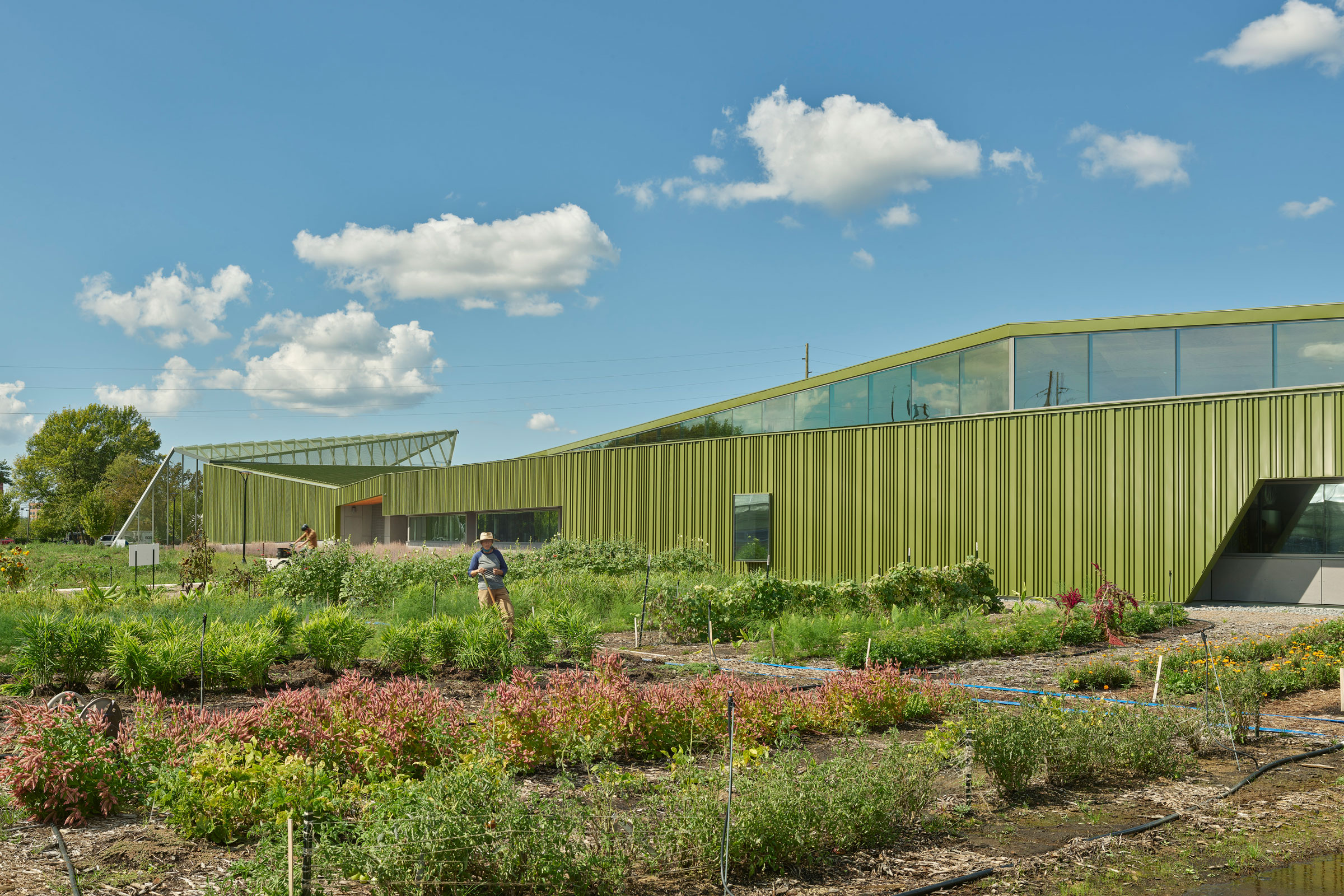
A lush landscape adjoins Thaden School’s Home Building, with Marlon Blackwell Architects’ Reels building in the background. Photo by Tim Hursley
In the quad field next to the Home Building, a geothermal well field acts as a giant battery and, alongside other efficient features, helps reduce overall energy costs. “The Home Building was designed to achieve an EUI of 23 or less. The baseline EUI for a typical high school building as defined by ASHRAE is 74 kBTU/sf*yr,” Christian Rodriguez, principal at EskewDumezRipple, wrote in a previous gb&d article. “This means the Home Building was designed to be approximately 70% more efficient than similar schools.”
Schools with an EUI of 25 or less are commonly considered to be zero energy ready—and with plans to add a rooftop photovoltaic solar array in the future, the Home Building is well on its way to achieving net-zero status.
5. Rain Harvest Home, Temascaltepec, Mexico
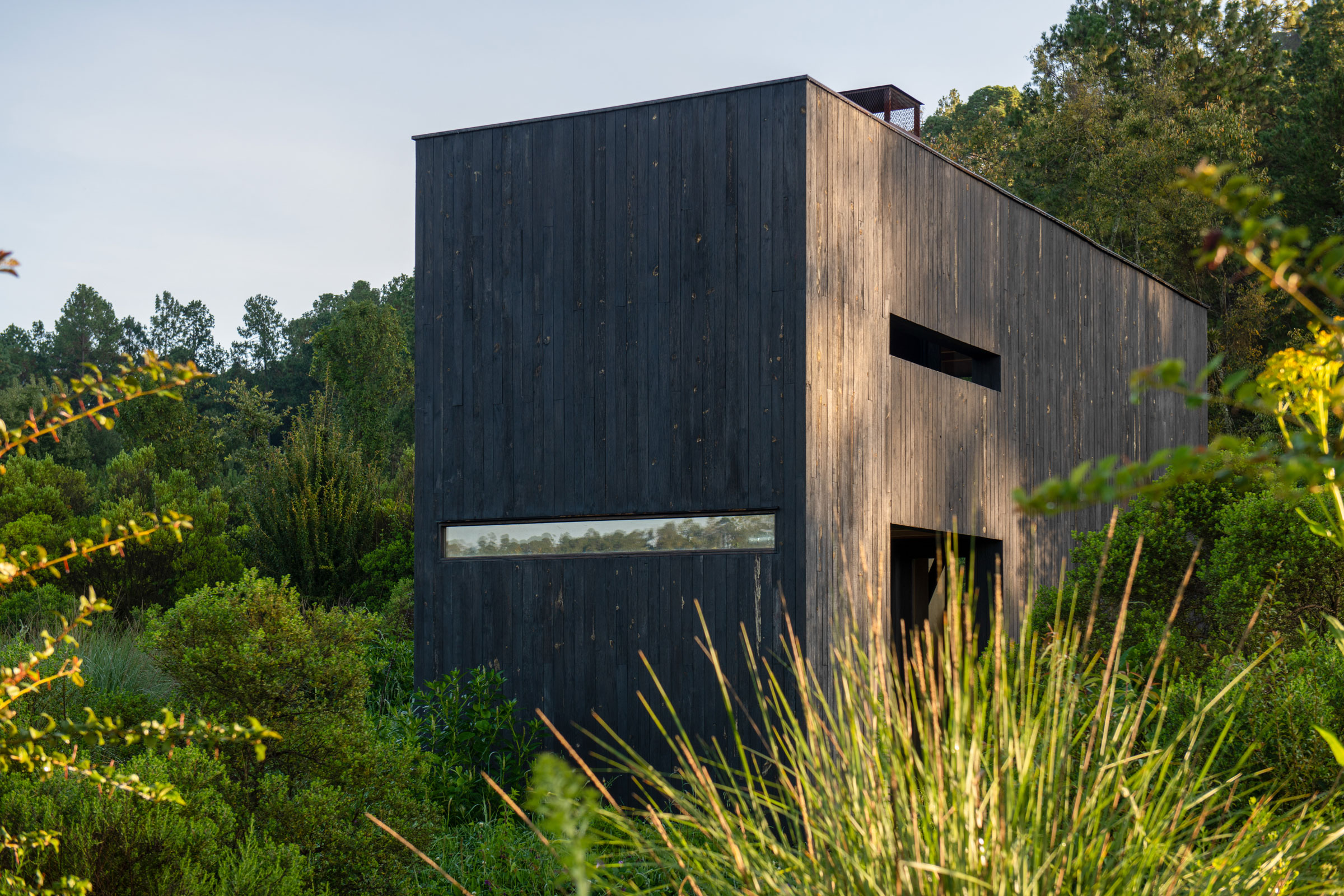
Outside the Rain Harvest Home. Photo by Jaime Navarro
Designed by Robert Hutchison Architecture (RHA) in collaboration with JSa Arquitectura, the water-autonomous Casa Cosecha de Lluvia—or Rain Harvest Home—in Temascaltepec, Mexico is an inspiring example of how effectively rainwater harvesting can be implemented when designing resilient buildings.
Located in the mountains about two hours south of Mexico City, the self-sustaining, off-the-grid Rain Harvest Home is part of the larger La Reserva el Peñón progressive development community and encompasses three structures: the main residence, a studio, and a detached bathhouse. Each building rests on a raised concrete plinth and is constructed almost entirely from wood to reduce the project’s overall carbon footprint and environmental impact.
As part of the community’s foundational regenerative design principles, each home in La Reserva is required to harvest rainwater for at least 60% of their water needs—but RHA decided to take this requirement a step further and maximize the site’s harvesting capacity to achieve total water-autonomy.
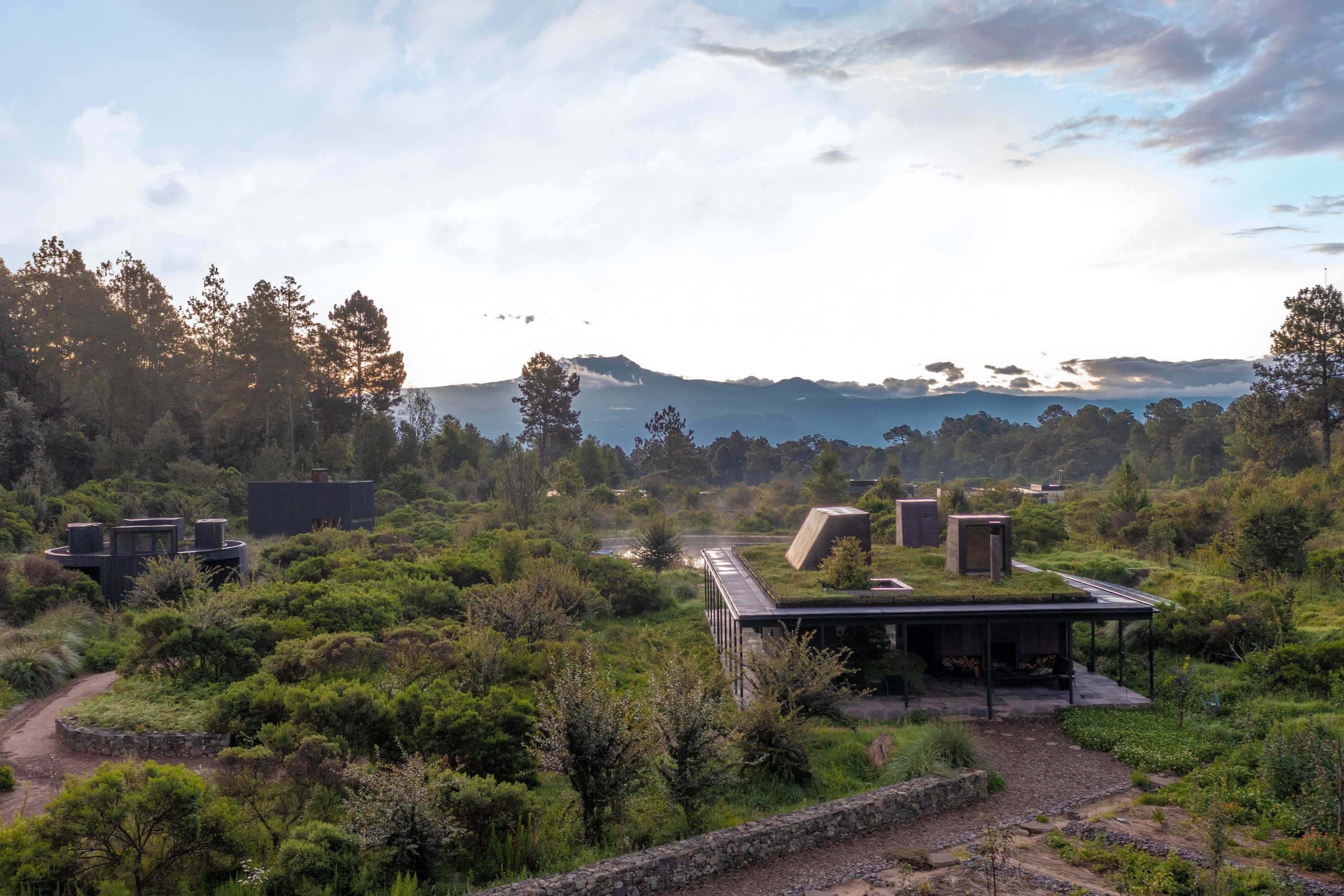
The Rain Harvest Home project is made up of three buildings that each collect rainwater to integrate with an above- and below-ground reservoir system. Photo by Jaime Navarro
All three buildings feature rainwater collection systems that all connect to a centralized, gravity-fed reservoir. There the water is treated and stored for future use, allowing the Rain Harvest Home to rely on rainwater for 100% of its water year-round. A chemical-free blackwater treatment system treats all of the wastewater produced onsite, after which it is returned to the site’s water cycle and reused to flush toilets and irrigate the landscape.
“It’s a big self-contained cycle, but I think the most important thing we did was just not to treat it as a system but to treat it as an experience, really thinking about how rainwater could be a way of living on the site,” Robert Hutchison, founder and CEO of RHA, previously told gb&d. “It’s not just a metric; it’s about experiencing and being a part of the site. Because when it rains for six months, to be in the bathhouse when it’s raining is a pretty visceral experience.”
Green roofs and bioswales also help channel and mitigate excess stormwater runoff while an on-site bio-agricultural garden and orchard allows the family to grow a large portion of their own food.
6. Urban Frontier House, Billings, MT
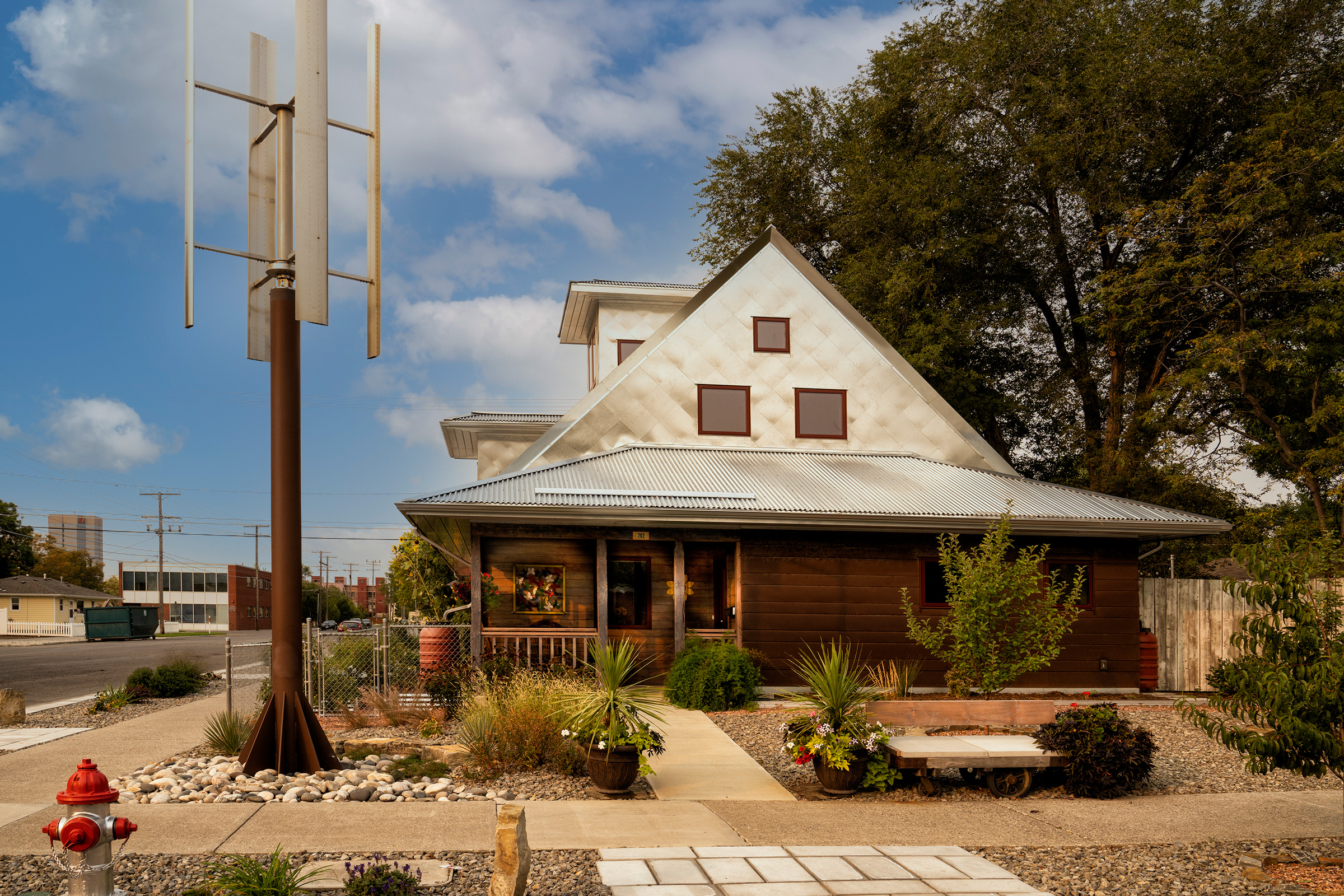
The LEED Platinum Urban Frontier House is a customized solution built by integrating existing systems in a new way to create a home that is scalable, replicable, and affordable. Photo by Clark Marten
Designed by High Plains Architects (HPA) to meet LEED Platinum standards, the Urban Frontier House in Billings, Montana strives to be an affordable, replicable, and scalable model for climate-resilient housing projects across the continental United States.
To reduce the Urban Frontier House’s carbon emissions and overall dependency on fossil fuels, the HPA design team turned to renewable energy—specifically a 1 kW vertical axis wind turbine and 6.03 kW net-metered rooftop photovoltaic array. A partial DC microgrid helps minimize conversion losses from the two systems, allowing the home to generate more energy than it uses.
The Urban Frontier House is also entirely water-autonomous—virtually 100% of the home’s water arrives in the form of either rain or snow. All of the harvested water is stored in underground tanks with a combined capacity of 7,500 gallons; from there it is filtered, treated, and pumped to the residence’s potable water sources. Any and all greywater that drains from these systems is then collected, filtered through a biological primary filtration system, disinfected, and reused for toilets, the dishwasher, washing machine, and irrigation.
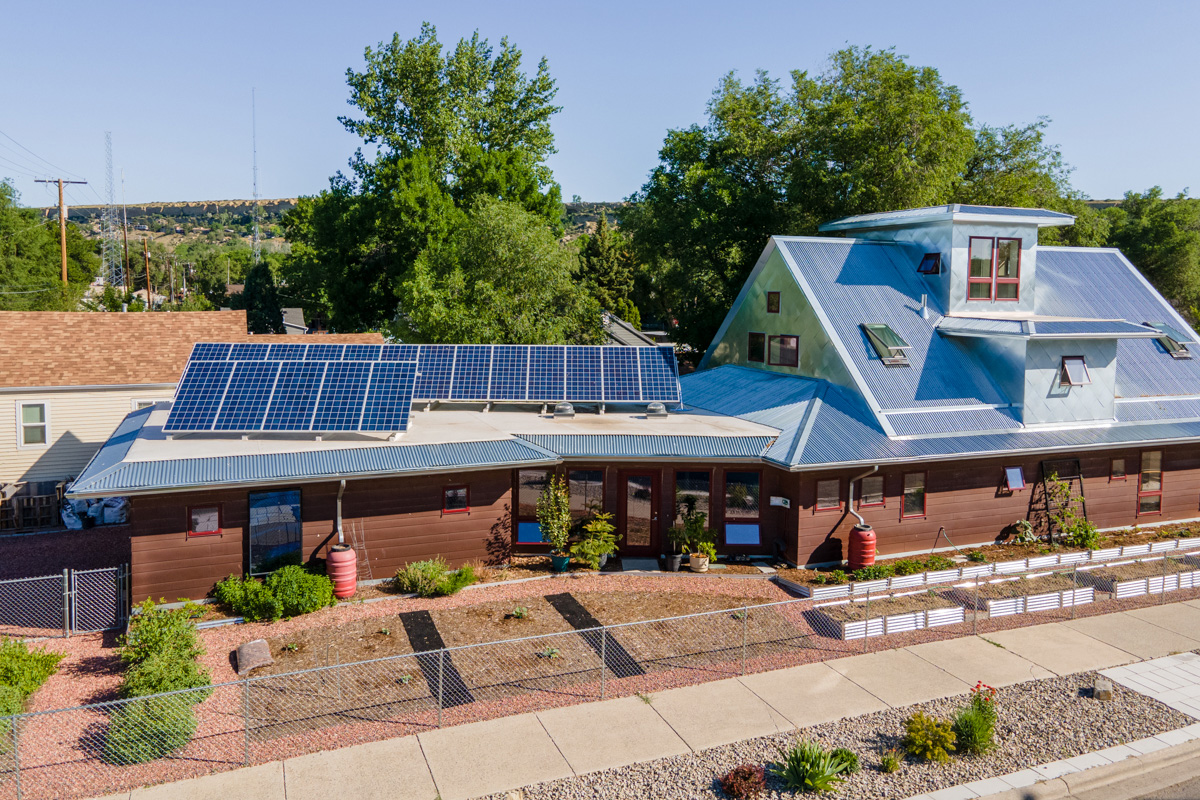
The Urban Frontier House achieved LEED Platinum. Photo by Nathan Satran
One of the biggest challenges in designing the Urban Frontier House, however, was ensuring that it was prepared to handle Montana’s radical temperature fluctuations, which range between -36 and 108°F. Despite these extremes the home features no active heating or cooling but instead relies on overlapping structural insulated panels, abundant daylighting, blinds, a passive ventilation system, and circulated sun-warmed air to help the home regulate heat gain/loss throughout the year. A four-seasons Garden Room also serves to naturally filter indoor air.
The home was also designed to comply with ASHRAE 62. “The owners were assisted by the Rocky Mountain College Computer Science Department to install sensors to track and monitor the levels of carbon dioxide, temperature, and humidity. The home has proven to maintain a relatively stable indoor temperature year-round,” Alex Tyler, marketing manager and project designer at HPA, previously wrote for gb&d.
7. Dayton Metro Library, Dayton, OH
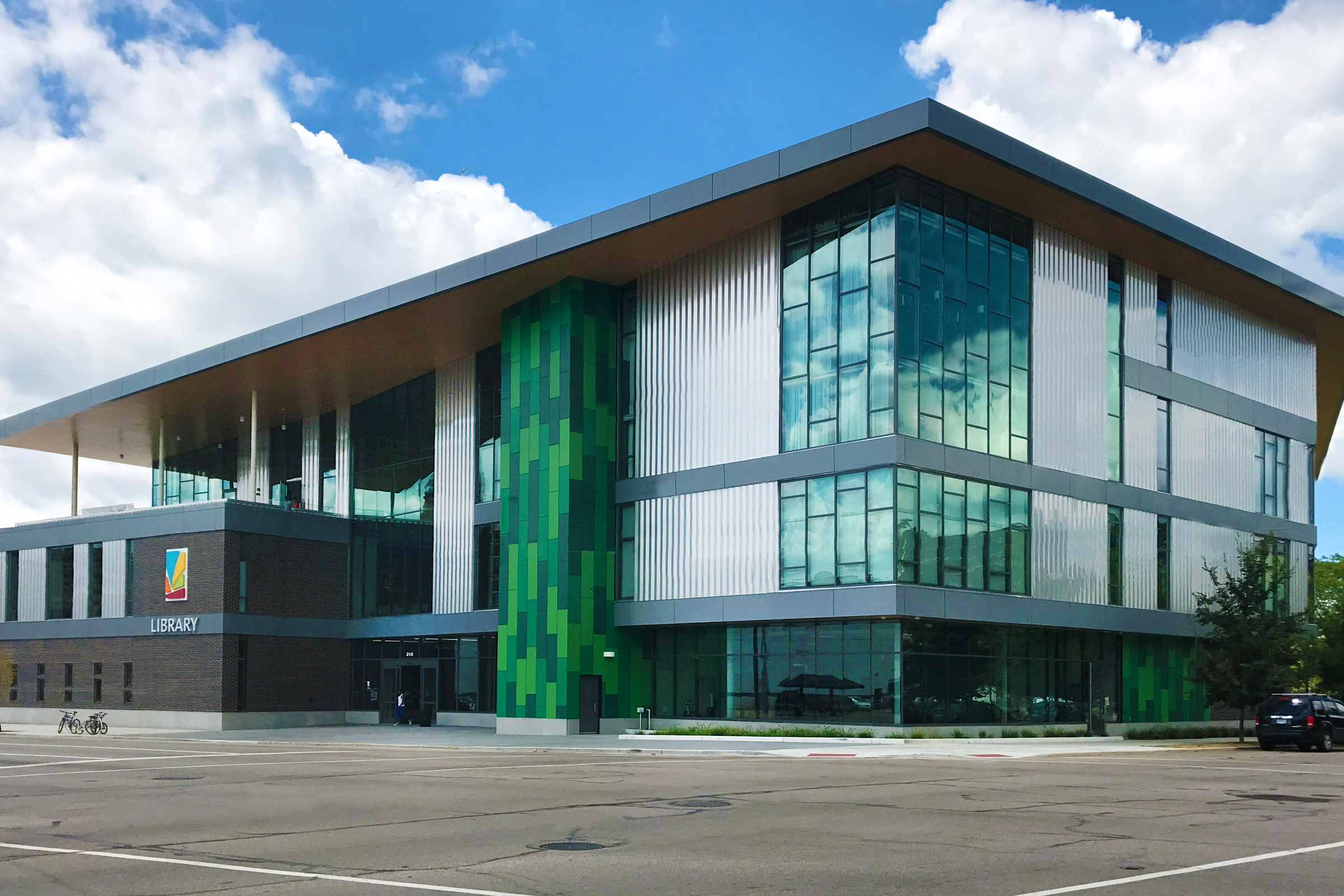
The LEED Gold-certified Dayton Metro Library is much more energy- and water-efficient than your standard library. Photo courtesy of HEAPY
Historically libraries have been in the center of cities and communities all over the world, whether they are big, small, underfunded, or overcrowded. When Dayton Metro Library decided to invest millions in their library system, they did so with resiliency in mind. “We set out to build facilities that were both aesthetically pleasing and welcoming to all patrons, creating a shared space that would bring the community together and improve access to everything from education resources and job readiness programs, to art, music, and technology,” said Jayne Klose, community engagement manager at the Dayton Metro Library, in a previous gb&d article.
Upon restructuring, they partnered with engineering design firm HEAPY to ensure their resiliency dreams could be realized in the 224,000-square-foot space. The main library branch in Dayton is now LEED Gold-certified, noting its reduced water use, energy efficiency, and community connectivity. It includes plentiful natural light and functional space, not to mention a rough savings of $1 million dollars in energy costs in the coming years.
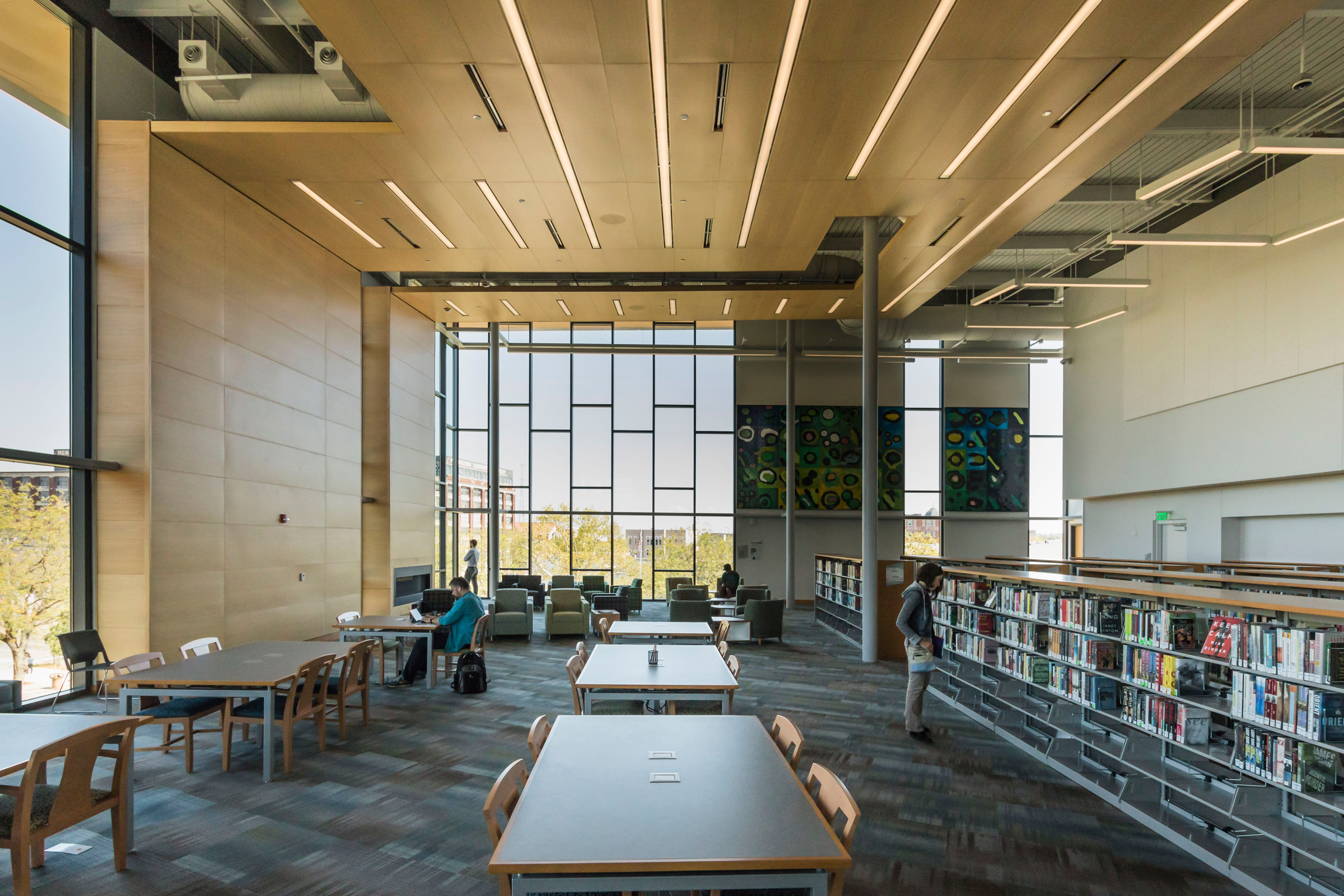
Ample daylighting illuminates the Dayton Metro Library’s interior. Photo by Andy Snow
“Good planning and design are useless without ensuring appropriate maintenance and long-term building optimization because building systems can drift over time and become less efficient,” Nicholas J. Andrews, project manager at HEAPY, told gb&d in a previous article.
Dayton Metro Library on average now uses 35% less electricity than a standard library and 38% less water than a similar building. The renovated branch and its counterparts now cost less to maintain and operate. which adds to Dayton’s commitment to resiliency in the community.
8. Zibi, Ottawa
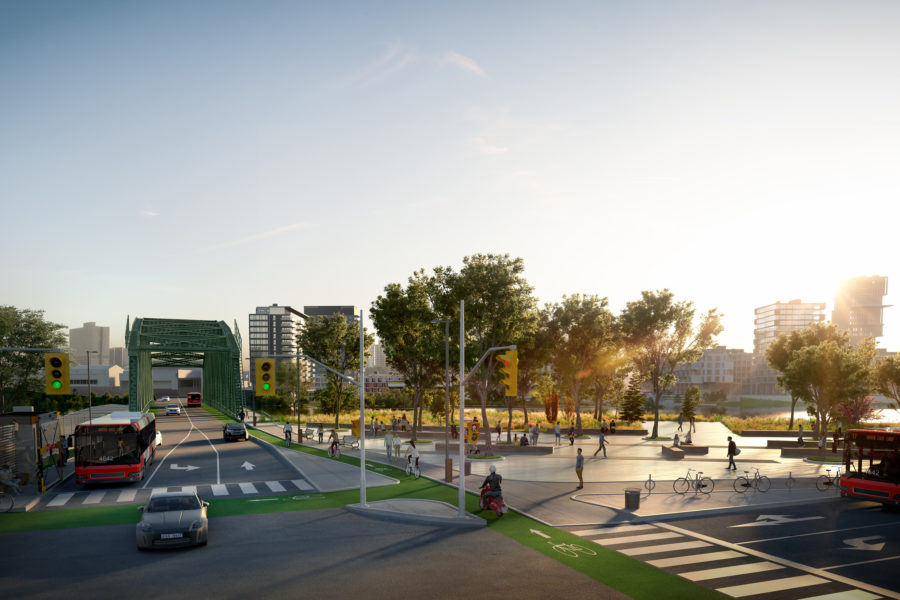
Zibi aims to achieve a Community Walkscore greater than 90 by 50% of project completion. Rendering courtesy of Zibi
Canada’s Zibi, straddling cities and provinces, is a new 34-acre planned community disrupting the culture of city planning. Following the United Nations’ Sustainable Development Goals as well as the One Planet Action Plan, Zibi committed to reducing potable water usage, increasing walkability, repurposing building materials, and adding abundant green space. “Parks and plazas are in development comprising 22% of the overall site, encouraging active, social, meaningful lives to promote good health and well-being,” said Jeff Westeinde, president of Zibi, in a previous gb&d article.
Zibi was once the land of the Algonquin Nation and because of past industrial uses, the soil was quite contaminated. “This transformation has involved significant demolition, preservation, and site remediation across 34 acres to allow for the development of a full mixed-use sustainable community,” Westeinde previously told gb&d. Connecting Ontario and Quebec, and creating jobs in the process, the borderless community will be at 100% net zero carbon becoming a sustainable and resilient building example for cities to come.
9. Schoonschip Amsterdam, Amsterdam, the Netherlands
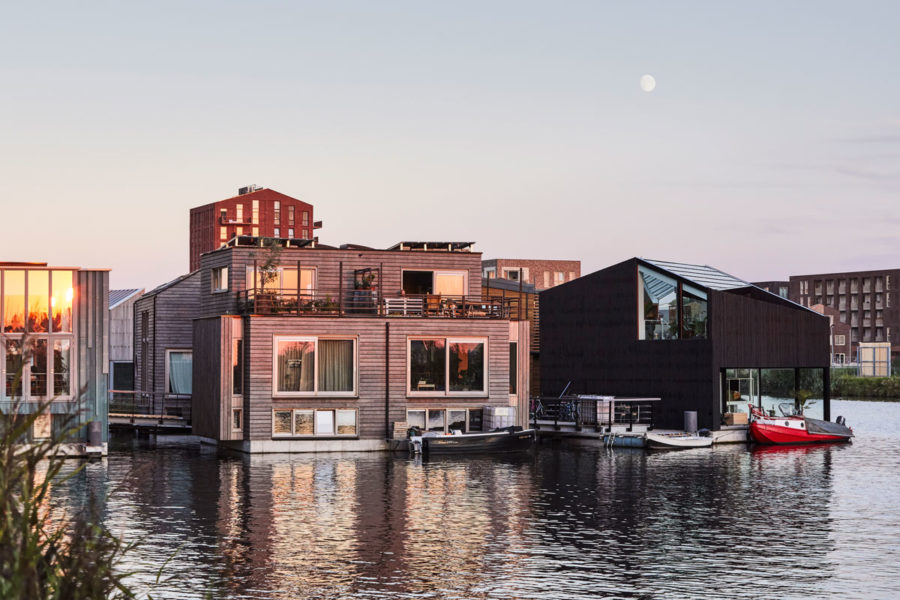
As an urban ecosystem embedded within the city, Schoonschip Amsterdam provides a new model for sustainable living. Photo by Alan Jensen
Designed by residents in collaboration with local architectural firm Space&Matter, Schoonschip Amsterdam is perhaps the most impressive example of resilient building in a city already rife with sustainable building projects. Its unrivaled ingenuity and holistic design have elevated a simple fascination for floating homes to what is now a circular, self-sustaining community housing nearly 100 people on the Netherland’s Johan van Hasselt canal.
An interconnected grid of 500 rooftop solar panels supplies electricity to all residences and uses blockchain technology to exchange energy between households, operating similarly to an energy cooperative. “If I’m at home and I generate electricity, and my neighbor is putting on the washing machine and doesn’t have electricity at the time, it’s all interconnected in a smart grid,” Yvonne Van Sark, a resident of Schoonschip Amsterdam, told gb&d in a previous article.
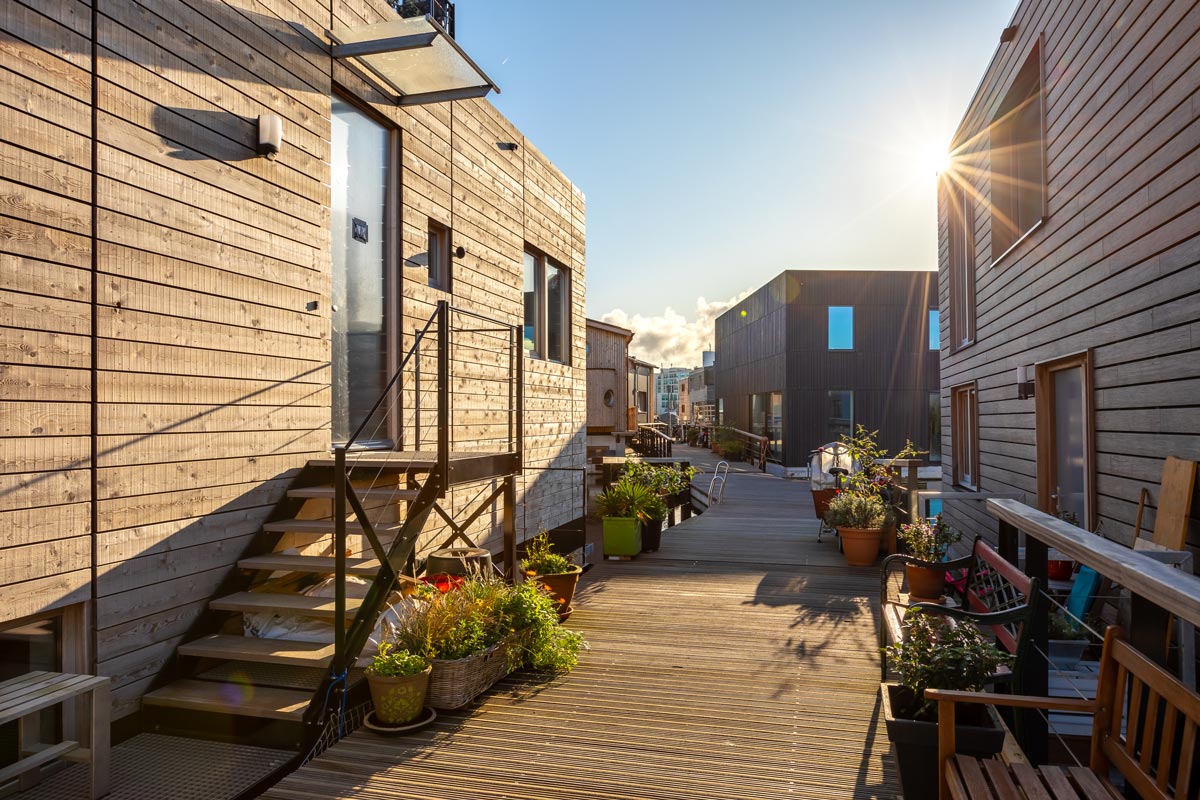
The jetty creates a social meeting space for residents, while also supplying the community’s energy, water, and waste systems underneath. Photo by Isabel Nabuurs
Schoonschip’s infrastructure was designed with the idea that each home takes some responsibility for the community as a whole. Every household’s energy, waste, and water lines are connected beneath the surface, and a jetty runs lengthwise with arms branching off like side streets to create micro-communities. By giving the residents the power to problem solve, they’ve created a culture of sustainability.
“Schoonschip is transformed into thriving neighborhoods based on regenerating existing nature and ensuring social, ecological, and financial value remains with the community. This ensures a network of stewardship and care, which will keep the neighborhoods operating in a circular way for perpetuity,” Sascha Glasl, cofounder of Space&Matter, previously told gb&d.
10. The Beach at Expedia Group, Seattle
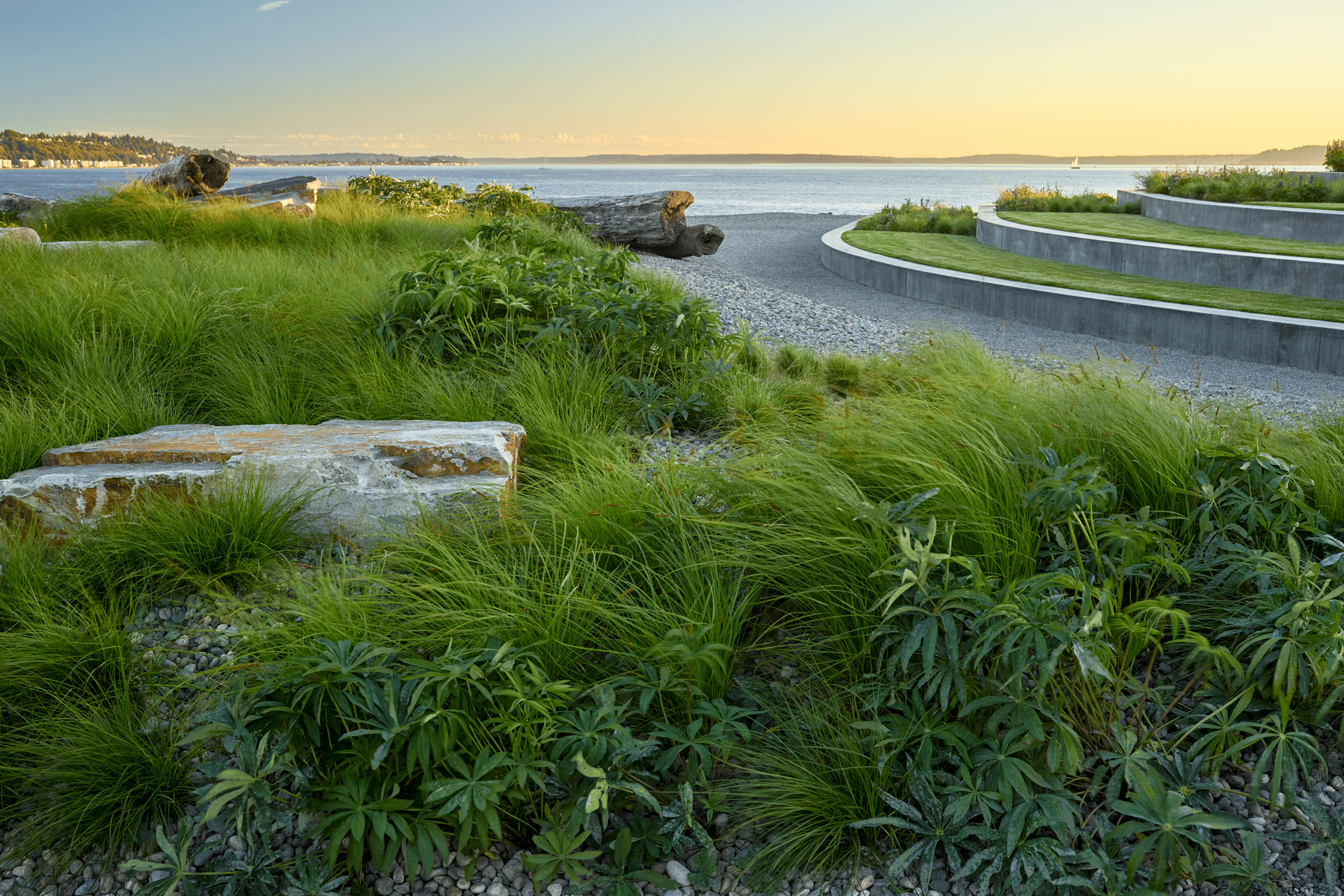
Expedia Group commissioned Surfacedesign to improve public enjoyment of its headquarters’ 2.6 waterfront acres. Photo by Marion Brenner
Another resilient building example sits slightly north of downtown Seattle: The Beach at Expedia Group’s HQ. Completed in 2019, the Expedia Group commissioned Surfacedesign to rework the 2.6 acre waterfront property to highlight the beautiful coastline and improve its longevity and resiliency.
The renovated coastal land connecting to the Elliott Bay Trail improved safety for cyclists and joggers, whereas it once succumbed to dangerous storm conditions. Upon rebuilding the property, local material reclamation and adaptive reuse were high priorities and among the strategies to increase the land’s resiliency. By including reclaimed stone and knotty spruce from a defunct log mill in neighboring Port Angeles, a naturalist setting for play and informal meetings took form.
Designed to enhance the beauty of Washington’s rugged coastline, the Surfacedesign team used several native grasses and perennials to create a space akin to what might be found in nature but also one that can withstand the Puget Sound’s stormy weather and rare but increasing heatwaves. Native plants like gumweed and wild buckwheat create texture and rhythm along the winding coastal meadow disguising their high weather tolerance for a less useful but dreamy landscape.
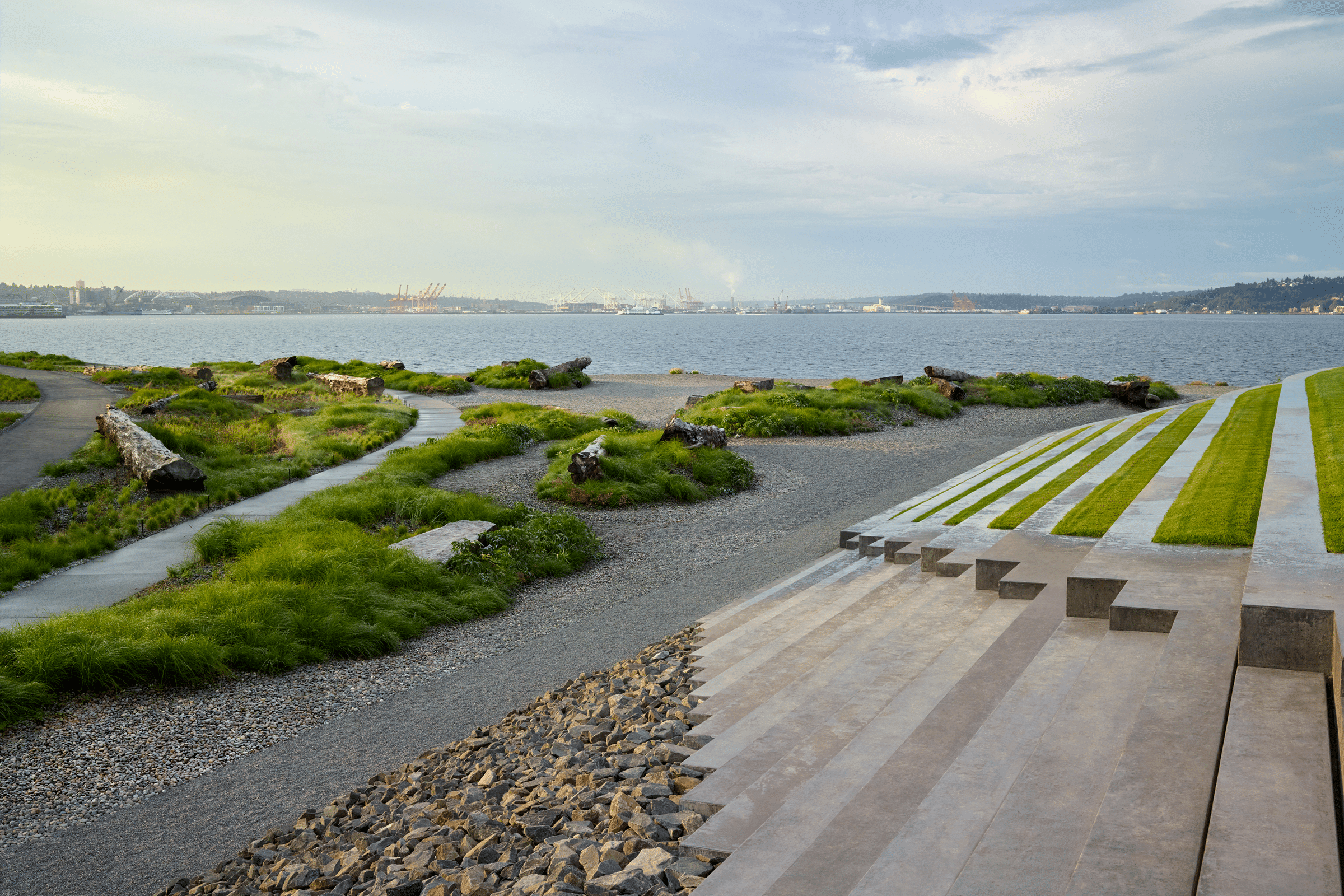
Gravel dunes and a terraced amphitheater aesthetically mitigate storm events, and bioretention meadows naturally filter runoff. Photo by Marion Brenner
Of all the aspects of Surfacedesign’s revitalization of the Beach, however, none were as integral as the introduction of an extensive soil program. Due to the site’s early development history, almost all existing soil had been depleted of key nutrients and was largely devoid of diverse microbiological life—what little healthy soil remained was collected and used to develop soil blends with similar characteristics to that of the site’s native soil.
“This approach established sustainable and resilient soils and planting communities that will continue to grow into natural balance with the Seattle environment,” Michal Kapitulnik, a partner of Surfacedesign, previously wrote for gb&d. “Soil testing and monitoring after installation informed formulation of compost tea blends used to seasonally inoculate the soil and plants, stimulating biological activity and resilience without the use of chemical fertilizers or other inputs.”
By cultivating a healthy soil profile, the team at Surfacedesign was able to effectively landscape with plants and grasses native to the Puget Sound. Special attention was focused on those plants capable of attracting and harboring wildlife so as to bolster and maintain taxonomic diversity.
11. Miami Beach Convention Center, Miami
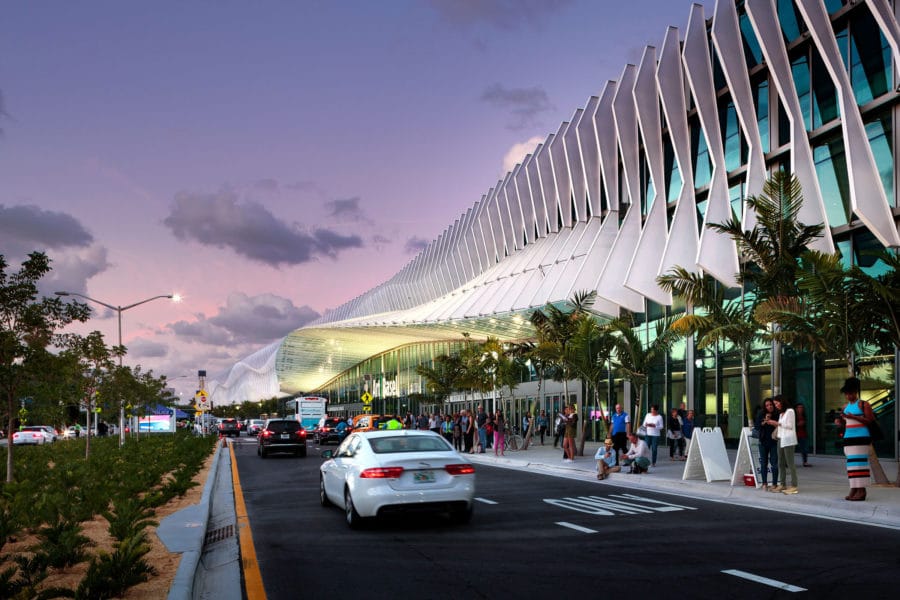
Photo by Tom Clark
Global design firm Fentress Architects redesigned the Miami Beach Convention Center in 2020 and achieved LEED Silver, making a huge leap in the direction of resilient building examples in Miami.
Known to hold prestigious events like Miami Art Basel and eMerge America, the 1.4 million-square-foot convention center was designed to mimic Miami’s vibrant landscapes and culture. The exterior facade of the building displays fin-like aluminum forms to exude a wave-like appearance. The fins respond to the sun’s orientation and filter light through the “wave,” making an easy transition from day to night.
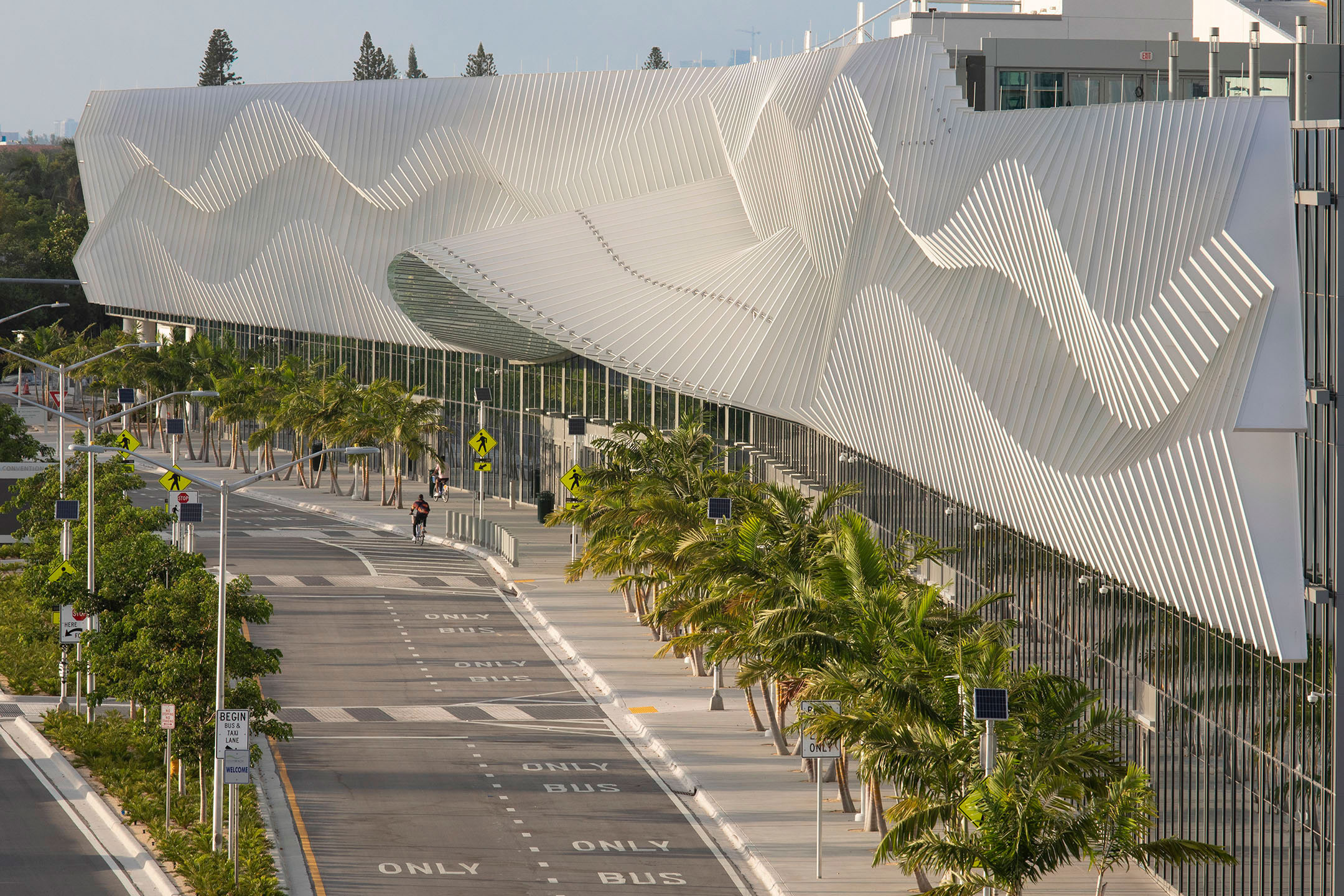
The context-driven design of the Miami Beach Convention Center reflects the natural elements of Miami’s acclaimed beaches, including waves, manta rays, and coral reefs. Photo by Robin Hill
To celebrate Miami’s natural environment, they’ve repurposed the six-acre parking lot transforming it into a vast public park including gardens, shaded areas, and game lawns. Adding a total of 12 acres of green space, heat island effect, wherein heat is absorbed and redistributed, is significantly reduced.
One more crucial aspect of the build was to move integral building systems to the second floor so as to create a resilient design that can withstand hurricanes common to the area. “This exciting milestone for the MBCC represents the culmination of a long journey, demonstrating the MBCC’s serious commitment to resiliency and sustainability,” said Freddie Peterson, general manager at the Miami Beach Convention Center, in a previous gb&d article.
12. The Dartmouth Waterfront, Dartmouth, MA
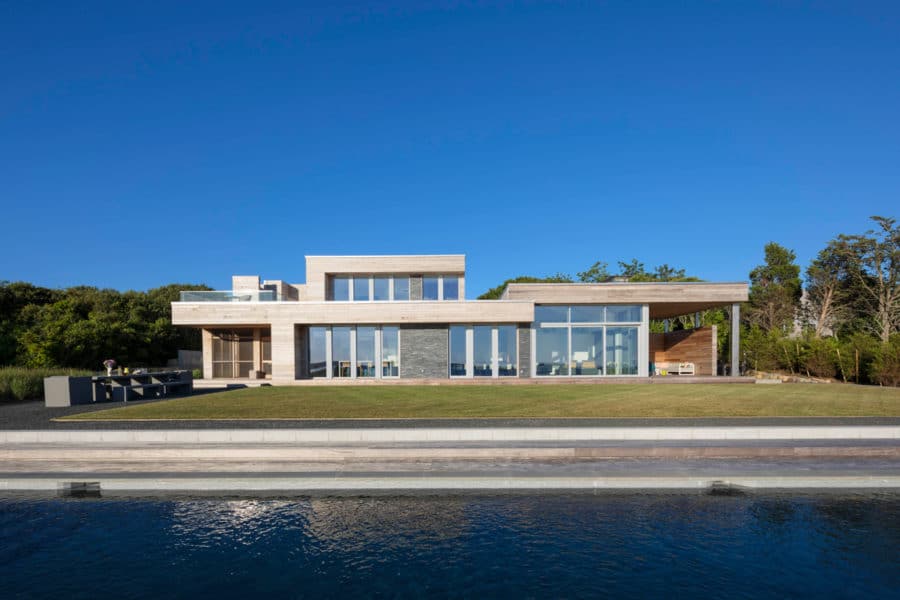
Photo by Greg Premru Photography
Situated on the coast of Massachusetts in South Dartmouth, a Boston couple’s dream comes to life through the work of ZeroEnergy Design. The 3,600 square-foot multi-level home needed to be a respite from the city and was designed in a way that the couple could age peacefully. Given that coastal buildings tend to require more maintenance than those inland due to their proximity to saltwater and its corrosive properties, the team used materials like stainless steel on the home’s exterior.
To offset energy consumption, the roof is accented by a photovoltaic array that produces nearly the energy that’s used within the home. Highly insulated and featuring exterior shades that also help reduce indoor temperatures and increase the home’s comfort. “If it’s not comfortable, it’s not a great space,” said Stephanie Horowitz, managing director of ZeroEnergy Design, in a previous gb&d article.
13. Louisiana Children’s Museum, New Orleans

Photo by Neil Alexander
Richard Franko’s love of educational spaces primed him to design the 56,400-square-foot Louisiana Children’s Museum (LCM) in New Orleans, a fresh take on resilient design featuring an integrative indoor-outdoor construction.
Due to New Orleans’ geography and the aftermath of Hurricane Katrina, the museum was designed to be able to withstand floods. “As that area becomes a receptor for stormwater during storm events, it will be able to accept water onsite and allow it to recede gradually,” Richard Franko, partner at Mithun, said in a previous gb&d article. They’ve even added an interactive cistern to collect rainwater for irrigation that both functions as entertainment and another element of education. The facades were designed to meet strict wind defense standards and passive shading reduces heat and increases radiant cooling throughout.
Paying special attention to the land’s topography, architects created outstanding views boasting the world’s largest collection of mature live oaks in the world. The museum has since gained LEED Gold certification and serves 250,000 visitors per year.
14. The New GAF Headquarters, Parsippany, NJ
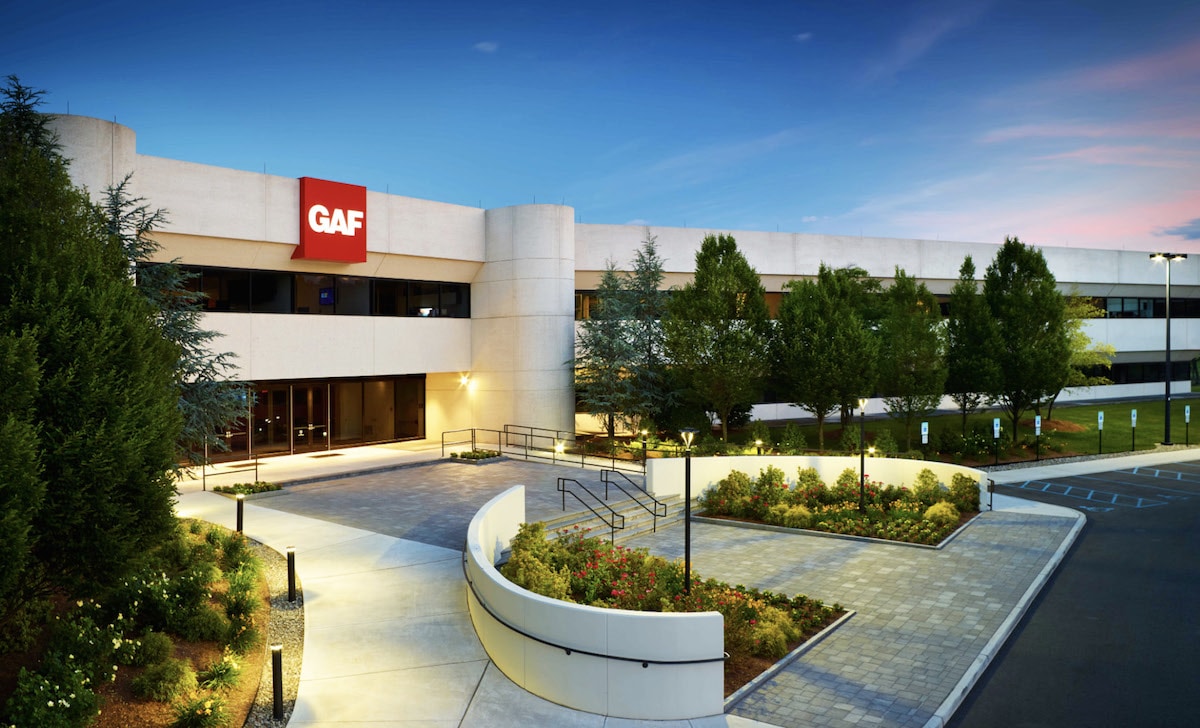
GAF’s new headquarters building was specially designed to withstand future storms. Photo courtesy of GAF
Prompted due to the devastation of Hurricane Sandy, GAF, the largest roofing manufacturer in North America, made the move to Parsippany, New Jersey, as a safety precaution for future storms. The new HQ building focused heavily on resiliency and as a result, became the first building in the world to earn the LEED IPpc98 credit for resiliency.
“The primary purpose was to be prepared for disasters and associated disruptions,” Ana Meyer, GAF’s executive director of sustainability, previously told gb&d. “Being the first LEED building to achieve a Resilient Pilot credit was the outcome of GAF following our focus and commitment to resiliency and sustainability.”
As roofing experts, the company used proprietary roofing insulation designed to withstand the damaging effects of future storms. Architects also made a point to build GAF’s headquarters and access roads on elevated land to safeguard against flooding.
In order to keep employees safe and avoid pauses in manufacturing, GAF installed major power systems with backup generators for emergency situations. Concerning day-to-day functions, in the event of a power outage stands an atrium lit by the sun enabling work to resume in the short term in the event of a power outage. Monthly safety training prepares employees for worst-case scenarios so GAF innovators can continue leading the industry.
15. Mercedes-Benz Stadium, Atlanta
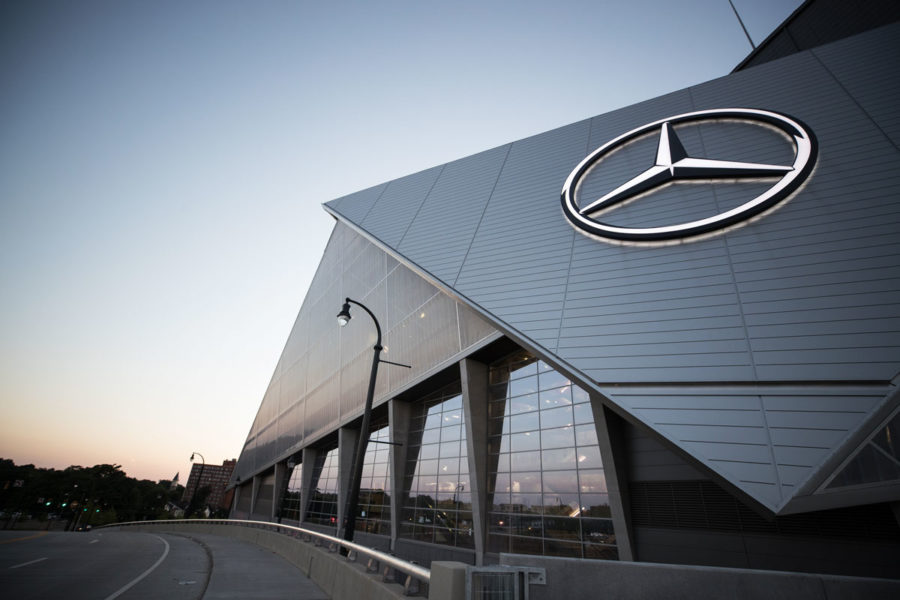
Mercedes Benz Stadium in Atlanta designed by HOK. Photo courtesy of AMBSE
The impressive 2 million square-foot stadium in Atlanta is a great resilient design example due to its array of green energy commitments. An estimated 4,000 panels installed throughout the project, including some at eye level, can power nine Atlanta Falcons games through solar energy alone.
The $1.5 billion dollar project, completed in 2017 and designed by HOK, also displays a massive halo board surrounding a larger-than-life video screen containing 63,000 feet of LED lighting. The choice to use LED lighting all throughout the project reduces energy usage by 60% and lasts 10 times longer than standard lighting options.
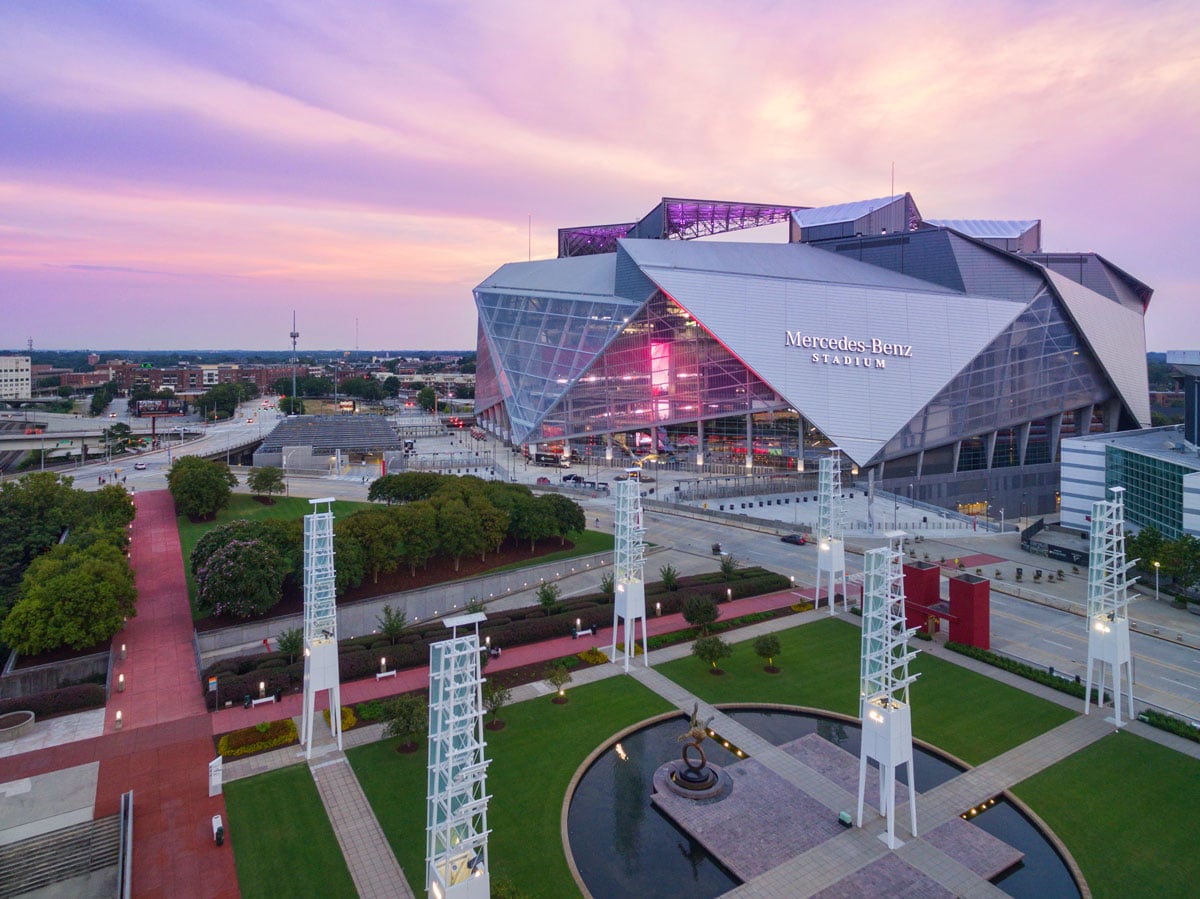
The Mercedes-Benz Stadium in Atlanta is the first LEED Platinum professional sports venue in the world. Photo courtesy of AMBSE
The Mercedes-Benz Stadium wouldn’t be a leader in resilient design without addressing water usage. Having gone underground, they installed a sophisticated stormwater management system that effectively reduced water usage by 47%. “Everything about this building was designed very intentionally to be innovative and groundbreaking from an environmental standpoint,” said Scott Jenkins, stadium general manager and chairman of the Green Sports Alliance, in a previous interview with gb&d.
Margaux Kelly contributed to this article.




